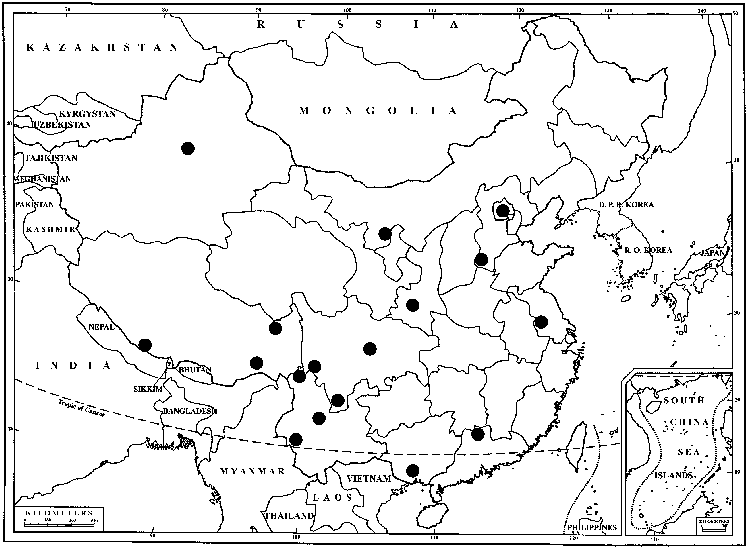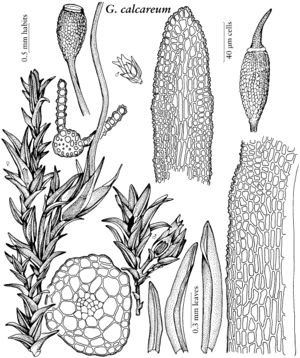Gymnostomum calcareum
in C. G. D. Nees et al., Bryol. Germ. 1: 153, plate 10, fig. 15. 1823,.
Plants light to dark green, loosely cespitose, crowded or sometimes forming a dense turf. Cauline leaves long-rectangular or less commonly lanceolate, straight to weakly reflexed apically, 0.4–0.6 (–0.8) mm, apex rounded to broadly acute, occasionally apiculate; distal marginal cells sometimes 2-stratose in patches, distal laminal cells 5–8 (–10) µm in width, 1–2: 1; distal adaxial costal cells elongate, occasionally shortrectangular or quadrate in robust plants. Specialized asexual reproduction absent. Perichaetia often multiple on an axis, terminating short or rather elongate lateral branches; perichaetial leaves usually stiff and often secund, narrowly lanceolate to triangular, commonly with all cells elongate, rectangular to rhomboidal, smooth or weakly papillose, occasionally quadrate distally but then perichaetial leaves lanceolate or very strongly sheathing in proximal half. Capsule elliptical, with a circumstomal collar and bulging exothecial cells, usually 30–40 (–50) µm wide.
Phenology: Capsules mature spring.
Habitat: Damp cliff faces and wet rocks near waterfalls
Elevation: low to moderate elevations (150-700 m)
Distribution

Calif., Mo., N.C., Mexico (Tamaulipas), Eurasia, Africa, Atlantic Islands (Azores), Atlantic Islands (Canary Islands), Indian Ocean Islands (Reunion), Pacific Islands (New Zealand), Australia
Discussion
Gymnostomum calcareum has been widely reported for North America, but H. A. Crum and L. E. Anderson (1958), after considerable study, indicated that all reports were G. aeruguinosum. R. H. Zander (1977) synonymized the two species, citing intergradation of important features. With recent discoveries of material widely distributed in California, the question was reopened and a re-examination of authentic material from Europe revealed apparently overlooked traits. Vegetatively, G. aeruginosum grades into G. calcareum at least in North America, with G. calcareum more often in tight turfs, being generally a smaller plant, often with strict leaves having rounded leaf apices and sides nearly parallel, and distal laminal cells slightly smaller. The perichaetia, however, are usually lateral on the main axis, terminating a short branch (though this branch is somewhat longer than that found in Anoectangium, e.g., A. handelii also known for California) and the bracts are much like those of Anoectangium. The capsules of most specimens have bulging exothecial cells, but occasional specimens of what are clearly G. calcareum have capsules typical of G. aeruginosum. The perigonia of G. aeruginosum have rather acute, somewhat modified bracts, and these should not be mistaken for the perichaetia of G. calcareum. A general survey of Gymnostomum in North America indicates it is restricted to California, one station in Missouri (Clayton), one in North Carolina, and is confirmed for Tamaulipas in Mexico. The collection from Missouri has the characteristic small, strict, long-rectangular, apiculate cauline leaves, and well-differentiated perichaetial leaves of G. calcareum, but the capsule of G. aeruginosum; this intergrades with the concept of G. boreale Nyholm & Hedenäs, reported for Quebec by P. Boudier (2003), which is not here recognized for the flora area. The North Carolina material has long been reported as Anoectantium euchloron, a synonym of A. aestivum, being a warm-temperate and tropical blunt-leaved variant, but differs in the flattened U-shaped leaf section, perichaetia born on stalks longer than those of Anoectangium in series near the end of a stem, not directly from a lateral leaf axil, and perichaetial leaves mainly differentiated in proximal 1/2, not throughout except for the innermost.
Selected References
None.
